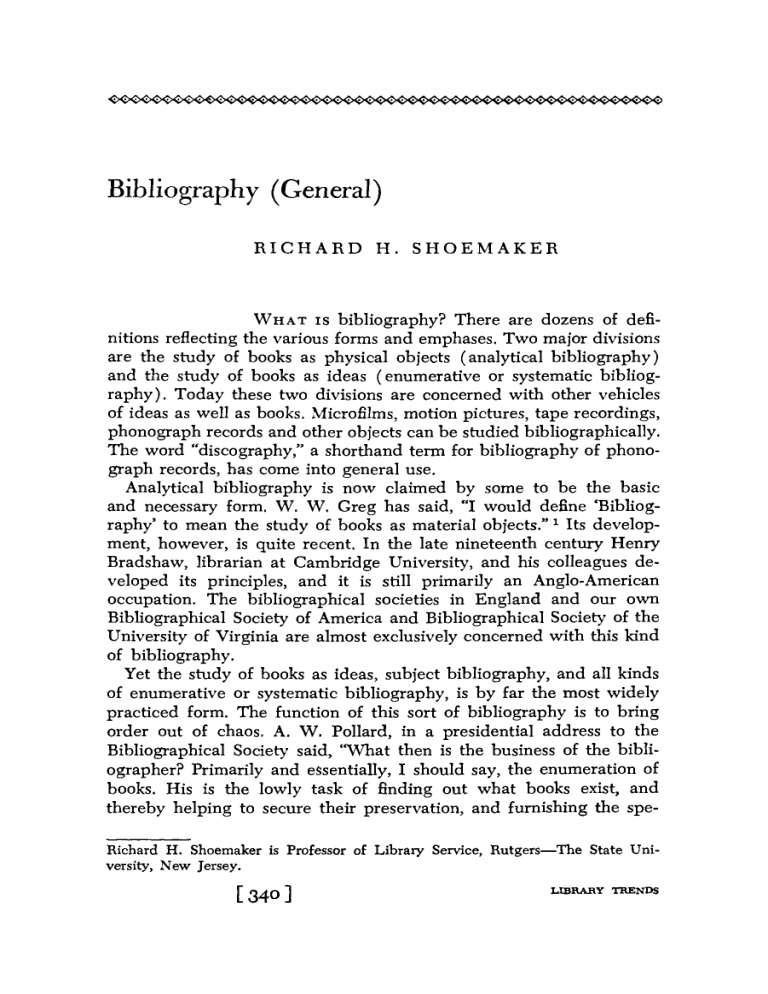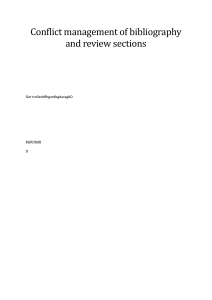
Bibliography (General) RICHARD H. SHOEMAKER WHATIS bibliography? There are dozens of definitions reflecting the various forms and emphases. Two major divisions are the study of books as physical objects (analytical bibliography) and the study of books as ideas (enumerative or systematic bibliography). Today these two divisions are concerned with other vehicles of ideas as well as books, Microfilms, motion pictures, tape recordings, phonograph records and other objects can be studied bibliographically. The word “discography,” a shorthand term for bibliography of phonograph records, has come into general use. Analytical bibliography is now claimed by some to be the basic and necessary form. W. W. Greg has said, “I would define ‘Bibliography’ to mean the study of books as material objects.”’ Its development, however, is quite recent, In the late nineteenth century Henry Bradshaw, librarian at Cambridge University, and his colleagues developed its principles, and it is still primarily an Anglo-American occupation. The bibliographical societies in England and our own Bibliographical Society of America and Bibliographical Society of the University of Virginia are almost exclusively concerned with this kind of bibliography. Yet the study of books as ideas, subject bibliography, and all kinds of enumerative or systematic bibliography, is by far the most widely practiced form. The function of this sort of bibliography is to bring order out of chaos. A. W. Pollard, in a presidential address to the Bibliographical Society said, “What then is the business of the bibliographer? Primarily and essentially, I should say, the enumeration of books. His is the lowly task of finding out what books exist, and thereby helping to secure their preservation, and furnishing the speRichard H. Shoemaker is Professor of Library Service, Rutgers-The versity, New Jersey. [ 340 1 State Uni- LLBRARY TRENDS Bibliography (General) cialist with information as to the extent of the subject-matter with which he has to deal.” Daily, throughout the world, a spate of books and other bibliographical items is issued. Many subjects, many languages, huge numbers of ideas spill out in random order, much as do stock quotations on the high speed ticker of the New York Stock EXchange. To be meaningful to most people, the stock quotations must be arranged in a regular alphabetical table, with the day’s high, low and closing prices indicated. Bibliographers do much the same with the mass of material they find. They collect, classify, describe and arrange. The process of description of books in many cases involves analytical bibliography, so that a true enumeration of the various editions, states, issues of the same title may be made, for how can lists be made unless the objects are really identified? Of books, this is true, but of ideas and words, not so. They are not physical objects and therefore cannot be studied as such, Bibliography is now extended to cover ideas and even key-word-in-context lists. Here the idea is supreme, and the physical object is all but lost sight of, Perhaps lists of books or texts of articles should be termed macrobibliographies and lists of ideas or key-wmd-in-context should be called microbibliographies. Enumerative bibliography has become a tremendously broad field and threatens to become even broader as books and ideas multiply. The bibliographer today is faced with an almost infinite number of tasks which might be undertaken, The labor is hard, but for those who like this kind of work, the satisfaction is great. Elliott Coues, writing in 1897 about his monumental but never completed Universal Bibliography of Ornithology which he had started publishing in 1880, said, “I think I never did anything else in my life which brought me such hearty praise ‘in mouths of wisest censure’-immediate and almost universal recognition, at home and abroad, from ornithologists who knew that bibliography was a necessary nuisance and a horrible drudgery that no mere drudge could perform. It takes a sort of inspired idiot to be a good bibliographer, and his inspiration is as dangerous a gift as the appetite of the gambler or dipsomaniac-it grows with what it feeds upon, and finally possesses its victim like any other invincible vice.” The last general review of bibliography in all its aspects was published by Van Hoesen and Walter in 192fL4Bibliography is defined by them simply as “the science of books.” ti This is perhaps the broadest definition ever given. They divided the science of books into four groups which they called historical; bibliothecal; enumerative; and JANUARY, 1967 [ 341 1 RICHARD H . SHOEMAKER practicaL6 All library science and all the details of publishing were included. Verner Clapp, in the Encyclopedia Americana, has written a fine summary grticle on bibliography as “the name applied to (1) a science, ( 2 ) an art, or ( 3 ) the most typical product of the art.” In his definition, bibliography as a science is all-inclusive, while as an art, it is the skill necessary to practice the science. I t is difficult to see the distinction, for is not the necessary skill a part of the “organized body of knowledge which treats of books in all aspects, whether merely as physical objects, or whether also as vehicles of ideas”8 which is Clapp’s definition of bibliography as a science? There has been a large amount of publishing about bibliography since Van Hoesen and Walter. Outstanding in the field of analytical bibliography is the massive Principles of Bibliographical Description by Fredson Bowers of the University of Virginia, where this science flourishes more than at any other American university. The Bibliographical Society of the University of Virginia can take its place as an equal beside the Bibliographical Society of America, The Bibliographical Society ( London ), and the Cambridge Bibliographical Society. Its annual Studies in Bibliography,lo now edited by Bowers, are a monumental evidence of its work and worth. In the same year, 1949, that Princeton University Press published Bowers’ Principles, the University of Pennsylvania Press issued Standards of Bibliographical Description 11 containing three of the lectures given at Pennsylvania, in 1946 and 1947, by A. S. W. Rosenbach Fellows in Bibliography: “Incunabula,” by C. F. Buhler; “Early English Literature,” by J. G. McManaway; “Early Americana,” by L. C. Wroth. A third edition of Esdaile’s A Student’s Manual of Bibliography,12 revised by Roy Stokes, came out in London in 1954. Though a general guide and not entirely concerned with analytical bibliography, it should be considered a basic source of knowledge in this field. As the title indicates, it is not an exhaustive treatise, but a fine compendious treatment. One of the best works on the history and theory of bibliography is contained in a guide to bibliographies by Georg Schneider, who decided to omit this introduction from his fourth edition of Handbuch der Bib1i0graphie.l~ Ralph R. Shaw translated this section into English from Schneider’s third edition and Columbia University Press issued it, in 1934, as Theory and History of B i b l i 0 g r a ~ h y . lIt~ went out of print but was reissued in a photo-lithographic reprint in 1961 [ 342 1 LIBRARY TRENDS Bibliography (General) by Scarecrow Press. Schneider does not mean by the word “bibliography” the same thing as Buhler, Ckeg, Bowers or other analytical bibliographers. “This is a textbook treating lists of literature,” l5 says the author in the first sentence of his preface. Louise Noelle Ma1cli.s has written an excellent brief history of and guide to systematic bibliography, L,a Bibliographie,16 published in Paris in 1956. Theodore C. Hines translated it into English and Scarecrow Press issued it in 1961 as Bib1i0graphy.l~Where Schneider overemphasizes the contribution of German bibliographers, Ma1cli.s does the same for French, though both books are world-wide in scope. Theodore Besterman’s Beginnings of Systematic Bibliography,18 a second edition of which was published by Oxford University Press in 1936, is the standard history. There i s a third edition, Les De’buts de la Bihliographie Mbthodique,lg Paris, La Palme, 1950. This indefatigable bibliographer has, since 1939, produced three editions of his great World Bibliography of Bibliographies.20 The “third and final edition,” in four volumes, 1955-56, is mistitled, mbst fortunately for the world of books, for Besterman has issued a fourth edition, which he says is really the last. Theire is nothing quite like this tremendous effort by one bibliographer in modern times, if ever. For, at the same time, he edited the correspondence of Voltaire,21in 107 volumes. He also compiled the third edition of Zndex Bibliographicus, a Directory of Current Periodical Ahtracts and Bibliographies.22 A fourth edition 23 was begun in 1959 when the FddBration Internationale de Documentation issued Volume one of a projected four volume set. Volume two was issued in 1964. A most extensive and inclusive bibliography of bibliographies was begun in 1938 by the H. W. Wilson Company with the publication of Bibliographic Index, a Cumulative Ilibliography of Bibliographies.24 It follows the familiar scheme of issues in the form of a periodical, then annual volumes, and finally cumulated volumes of several years, Since it indexes bibliographies that are included in periodicals and books as well as those separately published, it is indispensable for anyone working in subject bibliography. An annual listing 25 with the same coverage as Bibliographic Index, but only in the German Ianguage, was begun in 1957 by VEB Verlag fur Buch- und Bibliothekswesen with the publication of lists for 1954 and 1955. No cumuIation is planned, only annual volumes. Still another new bibliography of bibliographies started publication in 1959 when the &st quarterly issue of Bibliographische Berichte, im Auftrag des Deutschen BibliJANUARY, 1987 [ 343 1 R I C H A R D H. S H O E M A K E R ographischen Kuratoriums 26 appeared in Frankfurt. The monumental Les Sources du Travail Bibliographique 27 by Louise Noelle Malcks first appeared. in 1950 and was immediately recognized as a major example of a bibliographical guide, I t was completed in 1958 when the last of its four volumes was published. It seems evident from this partial list of major publications since 1928 that the pace of bibliographical scholarship is accelerating steadily. Perhaps it is not growing exponentially as the literature that it is supposed to control is said to be,28 and perhaps the analytical bibliographers are too much in the ascendency in Great Britain and the United States. The necessity of using new tools, methods and machines to control the vast numbers of ideas will be treated in other papers in these two issues of Library Trends. We are in the electronic age and can never go back to the “good old days.” Electronic devices will be used, indeed, are being used, to control the output of electronic communication devices, including printing. Lawrence Thompson, in his W h o Killed Bibliography? 29 lists, rightly, the folklore of gadgetry as one of the assassins, while not denigrating the role of the machine as a servant. Certainly the Hinman Collator is a most useful device for the analytical bibliographer and the computer seems to be just as useful for his enumerative brother. The collator has made the identification of differences in copies of printed books very much easier to detect; the computer makes titles and the ideas contained in them much easier to store, and in some cases, to retrieve. Bibliography is not dead, or even ill. Machines and new methods are not lethal. The changes to come about will be large, but ideas will still be published in some form, and both the ideas and the forms will have to be controlled bibliographically. The invention of printing from movable types changed the methods of listing books and studying their form. Bibliography as we know it did not then exist, and perhaps the next century will bring forth some new name for it, but the job to be done will be the same. References 1. Greg, Walter W. “Bibliography-A Retrospect.” In The Bibliogruphical Society, 1892-1942; Studies in Retrospect. London, The Bibliographical Society, 1949, p. 24. 2. Pollard, Alfred W. “Practical Bibliography,” The Library, new series, 4: 158, April 1903. [ 344 1 LIBRARY TRENDS Bibliography (General) 3. Coues, Elliott. “Dr. Coues’ Column,” T h e Osprey, 2:39, November 1897. 4. Van Hoesen, Henry B., and Walter, Frank K. Bibliography: Practical, Enunterative, Historical, a n Introductoy Manual. New York, Charles Scribner’s Sons, 1928. 5. Ibid., p. 1. 6. Ibid., p. 3. 7. Clapp, Verner W. “Bibliography,” Encyclopedia An~ericann ( 1965), Vol. 3, pp. 674-77. 8. Ibid., p. 674. 9. Bowers, Fredson T. Principles of Bibliographic Description. Princeton, N.J., Princeton University Press, 1949. 10. Studies in Bibliography: Papers of the Bibliographical Society of Virgirlin. Charlottesville, Va., The University Press of Virginia, 1948/49- (continuing annually ) . 11. Biihler, Curt F., ed. Standards of Bibliographical Description. Philadelphia, University of Pennsylvania Press, 1949. 12. Esdaile, Arundell J. K. A Student’s Manual of Bibliography. 3rd ed. Rev. by Roy Stokes. London, G. Allen & Unwin and The Library Association, 1954. 13. Schneider, Georg. H a n d b w h der Bibliographie. 4th ed. Leipzig, Iliersemann, 1930. 14. Schneider, Georg. T h c o y and History of Bibliography. Trans. by Ralph Robert Shaw. New York, Columbia University Press, 1934. 15. Ibld., p. ix. 16. Malcks, Louise N. L a Bibliographie. Paris, Presses Universitaires de France, 1956. 17. MalclBs, Louise N. Bibliography. Trans, by Theodore Christian Hines. New York, The Scarecrow Press, 1961. 18. Besterman, Theodore. The Beginnings of Systematic Bibliography. 2d ed., rev. London, Oxford University Press, 1936. 19. Besterman, Theodore. Les Dkbuts de la Bibliographie Mkthodique. 3rd ed., rev. Paris, La Palme, 1950. 20. Besterman, Theodore. W o r l d Bibliography of Bibliographies. London, Printed for the Author at the University Press, Oxford, 1939-40. 2 vols.; 2d ed., London, The Author. 1947-49. 3 vols.; 3d and final ed., Geneva, Societas Bibliographica, 1955-56. 4 vols.; 4th ed., Lausanne, Societas Bibliographica, 1965-66, 5 vols. 21. Besterman, Theodore, ed. Voltaire’s Correspondence. Geneva, Institut et Muske Voltaire, 1953-65. 107 vols. 22. Index Bibliographicus: Direct0 y of Current Periodical Abstracts and Bibliographies. Comp. by Theodore Besterman. Paris, UNESCO, 1951-52. 2 vols. 23. Zndez Bibliographicus. 4th ed. The Hague, FBdkration Internationale de Documentation, Vol. 1, 1959, Science and Technology; Vol. 2, 1964, Social Sciences. 24. Bibliographic Index; A Cumulative Bibliography of Bibliographies. New York, H. W. Wilson Co., 1937-42. 25. Bibliographie der Deutschen Bibliographien. Bearbeitet von der Deutschen Bucherei. Leipzig, Veb. Verlag fur Buch- und Bibliothekswesen, 1957- , JANUARY, 1987 c 345 1 R I C H A R D H. S H O E M A K E R 26. Bibliographische Berichte, im Auftrag des Deutschen Bibliographischen Kuratoriums. Frankfurt am Main, Klostermann, 1959- , (continuing quarterly). 27. hlalcl$s, Louise N. Les Sources du Travail Bibliographique. Geneva, E. Droz, 1950-58. 3 vols. 28. Ridenour, Louis N. Bibliography in an Age of Science. Urbana, Ill., University of Illinois Press, 1951, pp. 5-29. 29. Thompson, Lawrence S. W h o Killed Bibliography? Berkeley, Cal., Peacock Press, 1965, p. 10. This small book is a reprint of an essay from The Unioersity of Kentucky Library Occasional Contributions, Vol. 13, No. 3, May-June 1962. LIBRARY TRENDS


